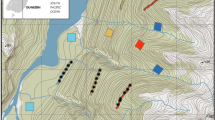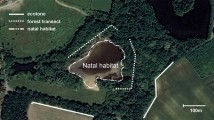Abstract
This study describes the demographic features of a population of Sigmodon hispidus utilizing the habitat mosaic provided by a Carolina Bay on the Atlantic coastal plain of South Carolina. A total of 71 cotton rats were captured 160 times on a 4 ha grid during a winter decline from 25/ha to less that 1/ha. Body weights of adults declined until early February and then increased; those of subadults grew very slowly until February followed by a spurt in growth. Weight gain did not differ between survivors and non-survivors for males, but female survivors gained 1.5 g per week more than non-survivors. Female subadults exhibited higher mortality early in the decline and males later.
Adult females were randomly distributed across 8 microhabitats, whereas adult males were almost exclusively confined to heavy Rubus cover. Subadult males used wet sites more than any other cohort; subadult females were widely distributed using drier sites most frequently. By the end of the decline, all survivors were localized in Rubus-dominated patches. No statistically significant changes in electromorph genotypes or allele frequencies were detected, but survivors had a higher frequency of the F-allele at the adenylate kinase locus than did non-survivors (42.3% vs. 16.7%).
Our findings affirm the importance of a landscape perspective in understanding the population dynamics of cotton rats, and show how a habitat mosaic influences survival differentially among sex-age cohorts.
Similar content being viewed by others
References
Anderson, P.K. 1970. Ecological structure and gene flow in small mammals. Symp. Zool. Soc. London no. 26: 299–325.
Goertz, J.W. 1964. The influence of habitat quality upon density of cotton rat populations. Ecol. Monog. 34: 359–381.
Golley, F.B., Gentry, J.B., Caldwell, L.D. and Davenport, L.B., Jr. 1965. Number and variety of small mammals on the AEC Savannah River Plant. Jour. Mamm. 46: 1–18.
Hansson, L. 1977. Spatial dynamics of field voles Microtus agrestis in heterogeneous landscapes. Oikos 29: 529–544.
Kincaid, W.B. and Cameron, G.N. 1985. Interactions of cotton rats with a patchy environment: dietary responses and habitat selection. Ecology 66: 1769–1783.
Kincaid, W.B., Cameron, G.N. and Carnes, B.A. 1983. Patterns of habitat utilization in sympatric rodents on the Texas coastal prairie. Ecology 64: 1471–1480.
Lidicker, W.Z., Jr., 1985. Population structuring as a factor in understanding microtine cycles. Acta Zool. Fennica 173: 23–27.
Odum, E.P. 1955. An eleven year history of a Sigmodon population. J. Mamm. 36: 368–378.
O'Farrell, M.J., Kaufman, D.W., Gentry, J.B. and Smith, M.H. 1977. Reproductive patterns of some small mammals in South Carolina. Florida Scient. 40: 76–84.
Schalles, J.F., Sharitz, R.R., Gibbons, J.W., Leversee, G.J. and Knox, J.N. 1989. Carolina bays of the Savannah River Plant. Pub. Sav. R. Plant Nat. Environ. Res. Park Program, Savannah River Ecology Lab., Aiken, South Carolina; 70 pp.
Schnell, J.H. 1968. The limiting effects of natural predation on experimental cotton rat populations. Jour. Wildl. Mgt. 34: 698–711.
Spencer, S.R. and Cameron, G.N. 1983. Behavioral dominance and its relationship to patch utilization by the hispid cotton rat (Sigmodon hispidus). Behav. Ecol. Sociobiol. 13: 27–36.
Wiegert, R.G. 1972. Avian versus mammalian predation on population of cotton rats. Jour. Wildl. Mgt. 36: 1322–1327.
Wiegert, R.G. and Mayenschein, J.C. 1966. Distribution and rap response of a small wild population of cotton rats (Sigmodon h. hispidus). Jour. Mamm. 47: 118–120.
Wood, J.E. and Odum, E.P. 1965. A nine-year history of fur-bearer populations on the AEC Savannah River Plant area. Jour. Mamm. 45: 540–551.
Author information
Authors and Affiliations
Rights and permissions
About this article
Cite this article
Lidicker, W.Z., Wolff, J.O., Lidicker, L.N. et al. Utilization of a habitat mosaic by cotton rats during a population decline. Landscape Ecol 6, 259–268 (1992). https://doi.org/10.1007/BF00129704
Issue Date:
DOI: https://doi.org/10.1007/BF00129704




